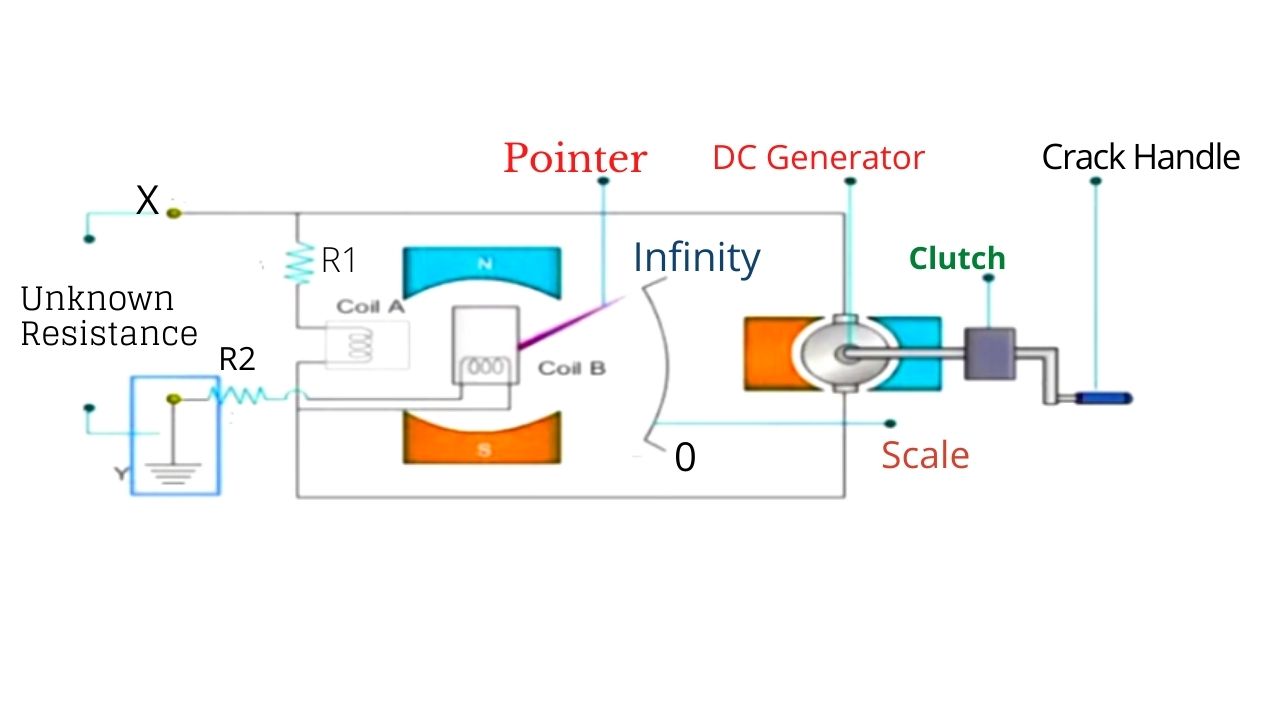MEGGER
What is a Megger?
Megger is a special type of portable instrument used to measure very high resistance of the order of megaohms. Resistance in the range of 0.1 Megaohm and above are classified as high resistances and to measure this high resistance we use Megger.
Megger is also called a special type of Ohmmeter used to test the insulation resistance of the cables. It is also known as an insulation tester.
Insulating components such as cable covers must be tested for their insulation strength at the time of commissioning and during maintenance of high voltage electrical equipment and installations.
Principle of Megger
Megger works on the principle of ratiometer or ohmmeter. The required deflecting torque is developed by both the voltage and the current.
Due to the interaction between the magnetic fields produced by both the voltage and the current, the deflecting torque is produced.
The coils used here are positioned in such a way that the deflecting torque is proportional to the ratio Voltage/Current i.e Td ∝ V/I.
Construction of Megger
It mainly consists of two main parts
(i) DC generator (ii) Ohm-meter
Here the hand rotated generator is rotated at the speed of about 140 to 160 rpm which can generate a voltage of 500v, 1000v, or 2000v according to the design of the Megger.
An ohmmeter is another part of the instrument which measures the resistance in megaohm. This part consists of two moving coils placed at a certain angle to each other and these coils rotate in between two poles of a permanent magnet with the help of a spindle and jewels.
In the case of Megger, three coils are present one is the current coil and two of them are the pressure coil or voltage coil. Here both the current coil and the pressure coil are made up of very fine wire with a few turns and are connected to the circuit through resistances R1 and R2 in series and parallel as shown in the figure.
A pointer is attached to the center of both the coils which indicates the reading from zero to infinity with the help of scale as shown in the figure. L and E are the two terminals of this instrument.

Working of the Megger
Step (1) Here the resistance to be measured is connected in series with the deflecting coil and across the generator. When current is provided to both current and the pressure coil then the torque produced by these coils are in opposite directions.
Step (2) If the resistance to be measured is very high then no current will flow through the deflecting coil. Then the controlling coil sets itself perpendicular to the magnetic axis and hence sets the pointer at infinity.
Step (3) when the resistance to be measured is of smaller value then a very high current flows through the deflecting coil and due to the resulting torques the pointer will set to zero or infinity.
Step (4) If the resistance to be measured is of intermediate value, then the pointer is set to infinity or zero depending on the value of the torques produced.
Hand-driven generator present is of permanent magnet type and it is usually designed to generate a voltage in the range of 500 to 2500 volts.
From the figure, torque (T1) developed due to current I1 = Torque (T2) developed by current I2.
i.e T1 = T2 ⇒ Fd1 = Fd2
B I1L SinѲ = B I2 L Sin(90+Ѳ)
B I1L SinѲ = B I2 L CosѲ
TanѲ = I2/I1 = V/ R2+Rx/V/R1
TanѲ = R1/R2+Rx
Ѳ ∝ 1/Rx
i.e Deflection ∝ 1/ Unknown Resistance
Types of Megger
|
|
Advantages of Electronic Megger
- Measurement accuracy is very high.
- It is robust and safe to use.
- It can be easily operated by a single person.
- Digital display is present in it which makes it easy to read the IR value.
- Its operation is less time-consuming.
- It can work well in a very small space.
- It is very compact and easily portable.
- It requires less maintenance as compared to other types.
Disadvantages of Electronic type Megger
- An external source of energy such as a dry cell or battery is required to energize the system.
- Its initial cost is very high.
Advantages of Manual type Megger
- Here to energize the system no external source is required.
- For Emergency use, this type is an excellent choice.
- This type is cheaper than the electronic type.
Disadvantages of Manual type Megger
- Accuracy is lesser than electronic type.
- Its operation takes more time means its operation is time-consuming.
- An analog result is provided by this type.
- In this case, the unstable placement of the tester may affect the result of the IR value.
- It requires very high care and safety during its operation.
Application of Megger
- It is used for testing an Earth or Ground connection.
- It is also used for Relay
- It is used for the measurement of the insulation resistance of the cable.
- Used for circuit breaker testing.
- Used for testing winding insulation of motor, generation, and transformer.
Points to Remember about Megger
- A clutch is provided in this instrument which is used to maintain a constant speed.
- Speed of Rotation is in the range of 110-160. In maximum cases, 160 is preferred.
- The minimum Voltage produced in the case of Megger is (40 – 500) Volt. But in the maximum question maximum voltage used is 500volt.
- The maximum voltage produced in the Megger is (500 – 1000) Volt.
- It is also called a direct reading instrument.
- Damping used is Air friction damping.
Frequently Asked Questions (FAQ)
Q1. What is a Megger?
(a)Source of EMF (b)Type of Null detector (c)Current Carrier (d)Source to Measure High resistance
Ans. (d)Source to Measure High Resistance.
Q2.What will be the Reading of Megger if measuring terminals are open-circuited?
(a)500ohm (b)zero (c)1000 ohm (d) infinity
Ans. (d) Infinity
Q3.What is the role of Permanent Magnet in Megger?.
(a)To provide voltage (b) To provide Magnetic field (c)To generate power (d) Balance the circuit
Ans. (b) To provide Magnetic Field
Q4. Supply to Megger is given by
(a) Ac generator (b) Ac motor (c) Permanent Magnet Dc generator (d) None
Ans. (c) Permanent Magnet Dc Generator
